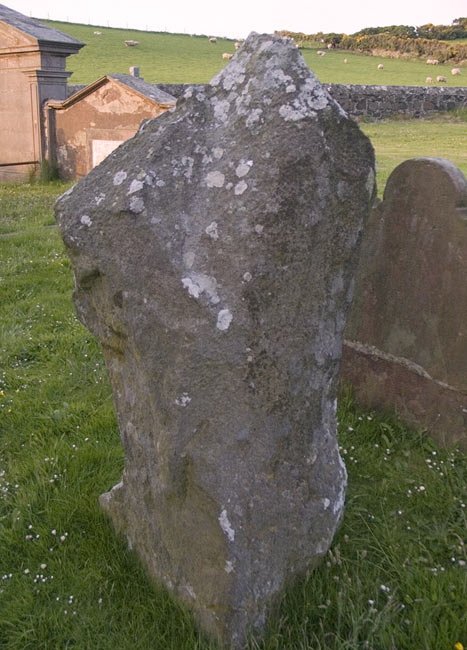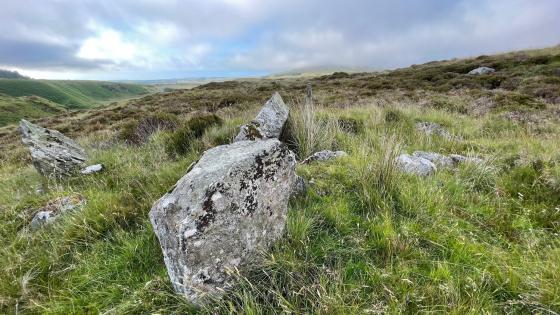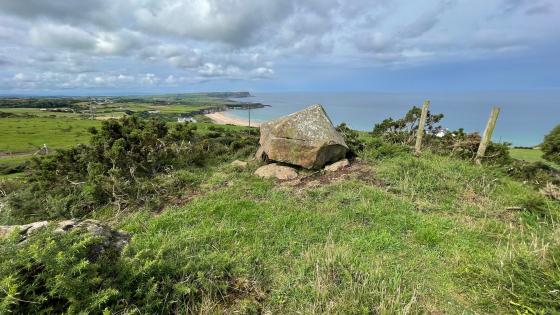
The two stones at either end of the church.

The two stones at either end of the church.

Looking west towards the western stone.

Eastern stone.

South-west with Knocklayd shrouded in cloud.

Another view of the smaller stone.

The smaller, broken stone at the eastern end of the church.

Another view of the large stone, with the moon rising in the distance.

The larger stone by the church porch. with a view towards Knocklayd mountain, obscured by the stone. There are a few drilled holes near the base of this stone that appear to have once been fixings for a metal gate, or railings, but all in all the stone seems to have taken the indignity of having a churchyard placed around it in its stride.

Wide view of the churchyard. The second, broken stone can be seen at the eastern (rear) end of the church, just to the left of the modern celtic cross headstone.
Just beyond the western end of the megalithic wonderland that lies north of the road from Ballyvoy to Torr Head is this odd pair of stones, possibly part of a larger stone row. The stone that you first meet as you walk up from the gate is a magnificent Obelix-dimensioned menhir, almost 3 and a half metres tall. It’s not often that I indulge in a bout of stone-hugging but this one is irresistible, its surroundings probably adding to my sudden melancholy sentimentality. Its amigo at the other end of the church was quite possibly of equal stature, once upon a time, but not now – it seems to have been broken at some stage and is quite deformed, especially when compared to its buddy. Once again, I discovered more information about a site after I had returned and read up a bit more. Must do better.
Ballynaglogh Standing stones, 08 June 2006.
Townland – Ballynaglogh (’Baile-na-gcloch’, ‘the town of the stones’)
Parish – Culfeightrin (’Cuil-eachtrann’ [Coolaghtran] ‘the corner (cuil) of the strangers’)
I decided to visit these stones after seeing the images posted by FourWinds. I live within a couple of miles of the site, and drive past it most days, but have never stopped to explore, so on a pleasant June evening I set off with my camera. Its probably the most easily accessable site that I have ever visited, right in the churchyard of Culfeigtrin (St Patrick’s) Church of Ireland, on the Cushendall Road (A2), just before the village of Ballyvoy. Ballyvoy is about 2KM east of Ballycastle, on the North Antrim coast.
A Massive three metre tall basalt stone stands guarding the church door, and another lies, seemingly broken in half, at the eastern end of the building. The broken portion appears to have been removed. Why this stone was defaced and not the other remains a mystery. Perhaps its phallic appearance was too much for the nineteenth-century congregation. There are reports of a third stone nearby, but I didn’t have the time to search for it as the light was fading.
The church was built in 1831, but amazingly I can find no details anywhere regarding the age of the stones, or their local significance. They don’t appear to be listed on the Archaeology data service website, but to my eye at least, appear to be perfectly genuine. FourWind’s theory about them being linked to the other outlying stones around Knocklayd mountain seems to make sense, although they are probably the largest standing stones that I have seen in the area, and a little further away from the mountain than some of the other stones. It certainly made a change from the usual toil up squelchy hillsides to visit the other megaliths in this area. Although never as impressive as stones left in their natural setting, they are certainly worth a quick visit. I will return, and try to locate the elusive third stone (if it exists) when I get a chance.





























